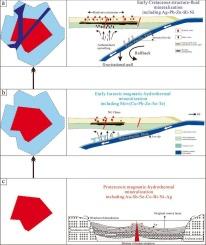New insight into the genesis of giant Maoling arsenopyrite-type gold deposit, Liaodong Peninsula, NE China
IF 3.6
2区 地球科学
Q1 GEOLOGY
引用次数: 0
Abstract
The genesis of the giant Maoling gold deposit in the Liaodong Peninsula of the North China Craton remains enigmatic due to the intricate gold distribution patterns and unresolved Au incorporation mechanism into arsenopyrite. The ore bodies are hosted by Proterozoic metamorphic rocks. Arsenopyrite is notably depleted in As and Fe but enriched in S. Gold contents in arsenopyrite, determined by the LA–ICP–MS spot analysis, range from 0.25 to 17.23 ppm. They are negatively correlated with Ag, Pb, and Bi, but positively correlated with Cu, Zn, Ni, Te and Se contents. Elemental concentration maps reveal Au-rich core, Mo-rich rim and Ag-rich microfracture within arsenopyrite. Our results, together with ionic radius and stoichiometric arsenopyrite, support the hypothesis that gold substitutes for Fe and As within the arsenopyrite crystal structure. New δ34S ratios determined on sulfides range from 6.9 ‰ to 10.9 ‰, closely matching sulfur isotope compositions of complex magmatic origin. Additionally, much low and linear distribution along the upper-crust trend, with values of 35.411 to 36.297 for 208Pb/204Pb, 15.430 to 15.486 for 207Pb/204Pb, and 15.800 to 16.477 for 206Pb/204Pb, respectively, thus pointing to a Proterozoic magmatic origin, with contributions from late-stage magmatic activity. Collectively, the available data support a three-stage hydrothermal history for Maoling gold deposit: Proterozoic intrusion-related gold event, a Jurassic intrusion-related molybdenum event, and Cretaceous structure-controlled silver hydrothermal event.

辽东半岛茂岭巨型毒砂型金矿成因新认识
华北克拉通辽东半岛茂岭巨型金矿床的成因仍是一个谜,主要是由于其复杂的金分布模式和未解的金在毒砂中的结合机制。矿体赋存于元古代变质岩中。LA-ICP-MS斑点分析表明,毒砂中砷和铁的含量明显减少,而硫则明显富集。与Ag、Pb、Bi呈负相关,与Cu、Zn、Ni、Te、Se呈正相关。元素浓度图揭示了毒砂的富金核、富钼边缘和富银微裂隙。我们的结果,连同离子半径和毒砂的化学计量,支持了金在毒砂晶体结构中取代铁和砷的假设。硫化物的新δ34S比值在6.9‰~ 10.9‰之间,与复杂岩浆成因的硫同位素组成密切匹配。208Pb/204Pb值在35.411 ~ 36.297之间,207Pb/204Pb值在15.430 ~ 15.486之间,206Pb/204Pb值在15.800 ~ 16.477之间,具有较强的上地壳低线性分布特征,表明其为元古代岩浆成因,并有岩浆活动的后期贡献。综上所述,茂陵金矿床的热液历史可分为三个阶段:元古代侵入期金事件、侏罗纪侵入期钼事件和白垩纪构造控银热液事件。
本文章由计算机程序翻译,如有差异,请以英文原文为准。
求助全文
约1分钟内获得全文
求助全文
来源期刊

Ore Geology Reviews
地学-地质学
CiteScore
6.50
自引率
27.30%
发文量
546
审稿时长
22.9 weeks
期刊介绍:
Ore Geology Reviews aims to familiarize all earth scientists with recent advances in a number of interconnected disciplines related to the study of, and search for, ore deposits. The reviews range from brief to longer contributions, but the journal preferentially publishes manuscripts that fill the niche between the commonly shorter journal articles and the comprehensive book coverages, and thus has a special appeal to many authors and readers.
 求助内容:
求助内容: 应助结果提醒方式:
应助结果提醒方式:


